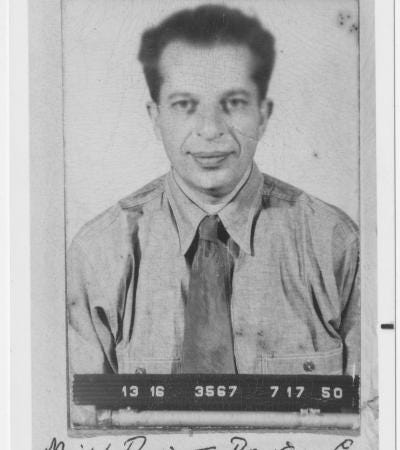I repeat, Mr. Maltz. Are you a member of the Screen Writers Guild?
Mug shot of screenwriter Albert Maltz taken when he entered Mill Point Federal Prison in West Virginia on July 17, 1950, for refusing to cooperate with House UnAmerican Activities Committee.
Like the union wins last year at the Amazon warehouse in Staten Island, the victories for unionization among Starbucks workers and the 90% strike vote by UPS Teamster members, the strike by actors and screenwriters is pretty damn impressive.
SAG/AFTRA President Fran Drescher is a most impressive spokesperson for, not just union actors, but for all of organized labor.
It was not always so.
In the 50s, SAG’s president was Ronald Reagan. He was part of a right-wing group in Hollywood who were nothing more than stooges of the studio owners.
Actors like Reagan, George Murphy and Robert Montgomery.
The difference between the studio owners in those days and today is that today the owners of the major studios make far more money and are way more ruthless.
In the 50s the studio executives used two tactics to drive down the livelihoods of Hollywood employees.
They managed to get those friendly to management into the leadership of the unions and they organized a campaign to rid the unions of Leftists, progressives and communists with the help of Congress and the House UnAmerican Activities Committee (HUAC).
That led to the Blacklist which denied work to anyone who didn’t name names and cooperate with the Committee.
Before SAG, the Hollywood bosses had created the Academy of Motion Picture Arts and Sciences in an effort to undermine union organizing.
During the 1920s, Louis B. Mayer (as in Metro-Goldwyn-Mayer) was among the most powerful men in Hollywood.
Among Louis B. Mayer’s greatest fears was the organization of a union movement in Hollywood among the trades that would lead to actors, directors and writers to form unions.
In January 1927, 36 directors, actors, writers, producers, and technicians attended an invitation-only banquet at a Los Angeles hotel for “an emerging organization titled the Academy of Motion Picture Arts and Sciences (AMPAS),”
At the party, Mayer told those gathered that if they signed on as members of the Academy, they’d get better working conditions and the prestige of being associated with an elite organization.
By creating a trade organization that represented writers, directors, and other creative workers, Mayer and his powerful friends figured it would keep them from following in the footsteps of Hollywood’s construction workers and unionizing.
That’s where the Oscars come into the story. The awards-giving body of the newly-formed academy would serve to distract creatives from attacking their bosses by forcing them to compete more ruthlessly with one another.
In Mayer’s own words, “I found that the best way to handle [moviemakers] was to hang medals all over them. If I got them cups and awards, they’d kill themselves to produce what I wanted. That’s why the Academy Award was created.”
Current SAG/AFTRA President Fran Drescher, in a Tweet a few years ago:
Times have changed.
Ronald Reagan and Louis B. Mayer must be rolling in their graves.





